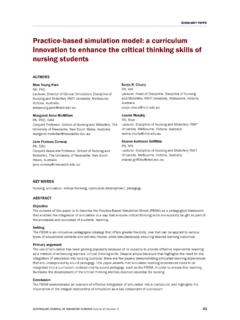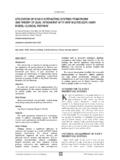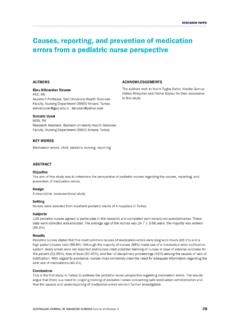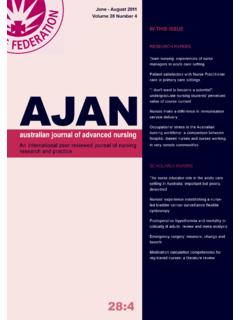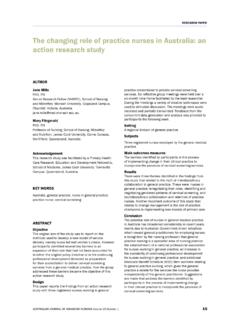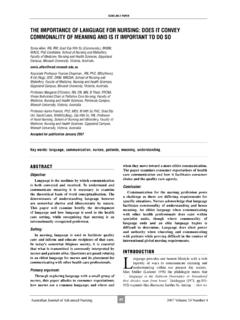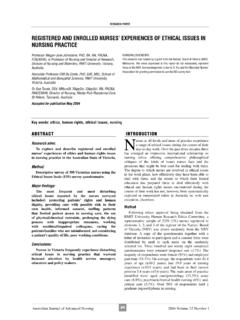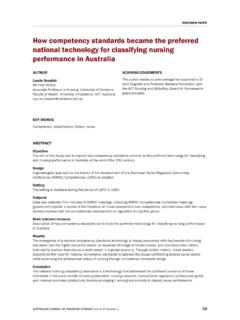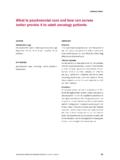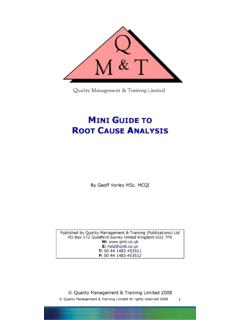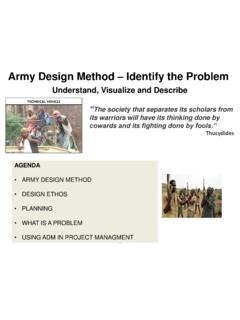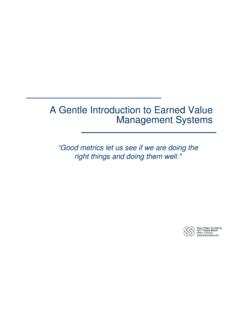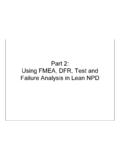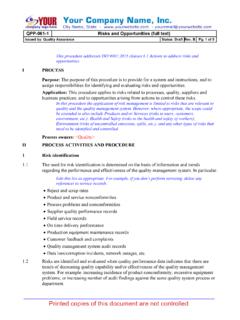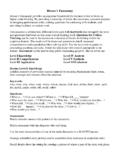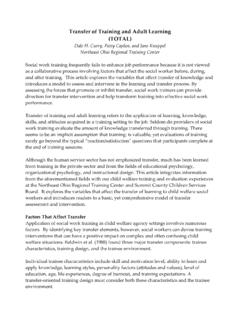Transcription of A nurses’ guide to the critical reading of research
1 AUSTRALIAN JOURNAL OF ADVANCED NURSING Volume 26 Number 1102 POINT OF VIEWAUTHORS Rebecca (Becky) Ingham BroomfieldRN (NSW), , (London), BSc, MSc, PhD student Lecturer, University of New England, Armidale, NSW, Australia. thanks to Dr Tricia Scott for her invaluable input into the first draftKEY WORDSR esearch critiquing, research methodology, evidence based practiceA nurses guide to the critical reading of researchABSTRACTO bjectiveA sound theoretical foundation to guide practice is enhanced by the ability of nurses to critique research . This article provides a structured route to questioning the methodology of nursing ArgumentNurses may find critiquing a research paper a particularly daunting experience when faced with their first paper.
2 Knowing what questions the nurse should be asking is perhaps difficult to determine when there may be unfamiliar research terms to grasp. Nurses may benefit from a structured approach which helps them understand the sequence of the text and the subsequent value of a research framework is provided within this article to assist in the analysis of a research paper in a systematic, logical order. The questions presented in the framework may lead the nurse to conclusions about the strengths and weaknesses of the research methods presented in a research article. The framework does not intend to separate quantitative or qualitative paradigms but to assist the nurse in making broad observations about the nature of the JOURNAL OF ADVANCED NURSING Volume 26 Number 1103 INTRODUCTIONN urses worldwide need to continually look for solutions, choices and outcomes for patients that represent the best available knowledge internationally (Hamer and Collinson 1999 ) to constantly improve and validate nursing care.
3 The Nurses and Midwives Board New South Wales (NMB NSW) Strategic Plan 2004 to 2007 includes an objective to promote education and research related to contemporary practice and educational programs leading to registration, enrolment and authorisation (NMB NSW 2006 clause 2). The United Kingdom Nursing and Midwifery Council (UK NMC 2002 clause ) require a registered nurse or midwife to maintain their professional knowledge and competence by delivering care based on current evidence, best practice and, where applicable and available, validated research . Such an objective can be achieved if nurses and midwives develop an understanding of the research process and demonstrate an ability to retrieve and critically assess research awareness is crucial to being a registered nurse or midwife.
4 Hamer and Collinson (1999) suggest nurses should be more questioning, try to see more than one side of an argument; try to be objective rather than subjective; weigh the evidence; make judgements based on reason, evidence or logic; look at the meaning behind the facts; identify issues arising from the facts; and recognise when further evidence is needed. A nurse is responsible to ensure that the standard of the nurse s practice conforms with professional standards with the object of enhancing the safety of the individual, any significant other person and colleagues (ANMC 2007 clause 2). This is echoed by the United Kingdom Nursing and Midwifery Council in their Code of Conduct which states: You are personally accountable for your practice.
5 This means you are answerable for your actions and omissions, regardless of advice or directions from another professional (UK NMC 2002 clause ). The importance of understanding, critically analysing and applying research becomes vital when so much rests on professional ability and the amount and complexity of available information and the limitations of a nurses time, there is the need to use a process which provides a concise way to analyse the results of research findings (Hamer and Collinson 1999).Critiquing ResearchThe essence of the successful critiquing of a research paper lies in achieving a balanced appraisal. The reader needs to look for the merits and demerits of the methods used as well as the applicability to the health care setting.
6 A balanced appraisal also requires a degree of logic and objectivity in identifying the systematic course of enquiry which underpins the research . The ultimate aim of any critique undertaken by nurses is to consider the applicability to MethodologyA research report should contain a carefully and concisely worded problem statement identifying key variables (Polit and Hungler 1997). research is often categorised as qualitative or quantitative, the former concentrating on words expressed by people in order to determine the reality of practice, whereas the latter tends to emphasise the use of numbers. Quantitative approaches to data collection and analysis have been developed within a traditional scientific ethos (Burns and Grove 2001) whereas qualitative research means any kind of research that produces findings not arrived at by means of statistical procedures or other methods of quantification (Strauss and Corbin 1990).
7 A quantitative approach may be chosen because the researcher wishes to collect information in a numerical form as the results will be based on rigour, objectivity and control (Burns and Grove 2001; Polit and Hungler 1997) whereas qualitative research allows the researcher to study things in their natural surroundings and attempt to interpret, or make sense of, phenomena (Denzin and Lincoln 2000).Mixed method research is a combination of quantitative and qualitative approaches. Complex concepts of interest in nursing may require both approaches to sufficiently study the phenomena. Examples of different data collection methods might include questionnaires, the use of physiological POINT OF VIEWAUSTRALIAN JOURNAL OF ADVANCED NURSING Volume 26 Number 1104instruments to measure patient responses, as well as observation techniques to provide a more rounded picture of the concept under study (Burns and Grove 2001).
8 The combined approaches are known as triangulation (Burns and Grove 2001; Polit and Hungler 1997). research Critique FrameworkTitleThe title should not be long and complicated and should reflect as much as possible what the research is about (Parahoo and Reid 1988). The title does not validate or invalidate the research (Parahoo and Reid 1988).AuthorRyan Wenger (1992) notes the authors brief biographies may be important sources of information about academic degrees, certification, position and place of employment, from which clinical and research expertise can sometimes be discerned. Occasionally the journal style means this information is not papers can be significantly delayed before publication.
9 It is important to determine whether the paper has been developed from a recent piece of work in order to assess its relevance to inform current practice (Polit and Hungler 1997).JournalThe editorial panel may be of interest. Members of the editorial panel or board may represent a combination of academic research and practice and may have either national or international abstract or summary should clearly outline the problem, the hypothesis or research question/s, aims and objectives of the study (Polit and Hungler 1997). It should also cite the methods, which may include either a qualitative or quantitative approach, or a combination of both, to collect the data, the results, conclusions and recommendations for practice (Parahoo and Reid 1988).
10 Abstract length is usually limited to between 100 200 words. Not all journals cite an abstract (Polit and Hungler 1997).Identifying the problemThe problem which initiated the research should be clearly described early in the report (Ryan Wenger 1992). In order to evaluate the value of the research it is important for the hypothesis, aims and objectives to be clearly and unambiguously stated as too many questions may indicate that too much is being attempted (Parahoo and Reid 1988).Literature SearchThe literature review is generally summarised in the introductory section or under a specific heading such as a review of the literature (Polit and Hungler 1997). Reference to original sources is important as information can be taken out of context and used inappropriately therefore an abundance of secondary sources should be viewed with caution as they may not provide sufficient detail or possibly distort some aspects of the original research (Polit and Hungler 1997; Burns and Grove 1993).
